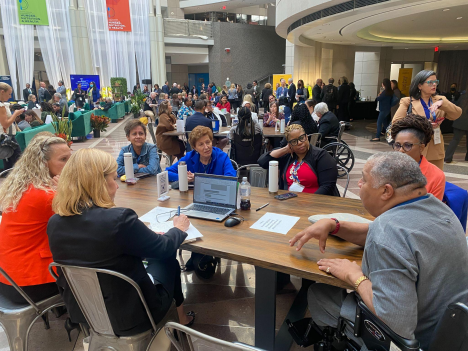Community
Local Nonprofit Attends Historic White House Conference on Hunger, Nutrition, and Health
GRRO’s executive director Henry Crews attended the conference and spoke with the members of the Biden-Harris administration asking them to consider the advantages of healthy food and how locally grown produce positively impacts hunger, health, local economies, and the environment.
For far too long we have neglected to provide equitable and adequate health care and food systems in parts of rural North Carolina. As we work to create greater access to healthier foods, we must take a deeper look at the cause and effects of those who have and those that don’t.
On September 28th members of the Green Rural Redevelopment Organization (GRRO), a Henderson, NC based nonprofit with a mission to reduce health disparities and improve health outcomes in rural communities across North Carolina attended the White House Conference on Hunger, Nutrition, and Health. This was a historic event given it has been more than 50 years since the first and only White House Conference on Food, Nutrition, and Health was held in 1969.

Henry Crews, executive director of the Green Rural Redevelopment Organization talks with conference attendees and members of the Biden-Harris administration about rural food insecurity and resources needed to move the needle on health disparities. (Provided Image)
The 2022 White House Conference aimed to catalyze the public and private sectors around a coordinated strategy to accelerate progress and drive transformative change in the U.S. to end hunger, improve nutrition and physical activity, and close the disparities surrounding them. The Biden-Harris administration shared their national strategy on hunger, nutrition and health and announced more than $8 billion in new commitments as part of their call to action during the White House Conference on Hunger, Nutrition, and Health.
GRRO’s executive director Henry Crews attended the conference and spoke with the members of the Biden-Harris administration asking them to consider the advantages of healthy food and how locally grown produce positively impacts hunger, health, local economies, and the environment.
resident Joe Biden delivers open remarks at the historic White House Conference on Hunger, Nutrition, & Health. September 28, 2022. Photo taken by Gregory Hedgepeth, Green Rural Redevelopment Organization
“Most health professionals recognize that nutritious foods are good for our health. Also, certain diseases, such as diabetes, hypertension, and heart conditions, can be controlled or prevented by consuming healthy foods. Some professionals have promoted food as medicine and we’re on the ground floor of this new initiative to promote produce prescriptions and ensure they can be a covered benefit for all eligible patients covered by Medicaid & Medicare.” – Henry Crews, executive director of the Green Rural Redevelopment Organization (GRRO).
Hunger and food insecurity were problems before COVID-19 and remain critical problems nationally and within North Carolina. Food advocates and the US government indicate that 12% of the population struggle with hunger, about 41 million people. North Carolina is the 10th most food insecure state in the nation; more than 585,000 families do not have enough to eat. Our children and seniors are most vulnerable. Low-income families and minorities in inner cities and rural communities are the most affected.
“To grow and sell healthier food locally, we must support and increase the number of small, minority, and female farmers. We must establish an infrastructure linking our public schools, farmers, extension services, health professionals, community colleges, and food stores,” said Former Congresswoman Eva M. Clayton, Board member for the Green Rural Redevelopment Organization and the Eva Clayton Rural Food Institute. “Our nation is losing farmers and farms rapidly, and North Carolina is currently tied for first in the US in the loss of farms. The average age of farmers in the state is 56. With our state population growth in the 2020s and continued growth expectations, there will be significant demand for new residential development, risking even greater loss of farmland.”
The Green Rural Redevelopment Organization with the help of Former Congresswoman Eva M. Clayton wrote the White House and laying out their own recommendations to increase locally grown healthy food that helps the hungry and the economy of rural communities. Highlighted in their letter they stated that policy makers must consider:
● Federal and state governments increase financial and technical support to small farmers to grow healthy food and sell it locally.
● Expand Farm to School Programs to promote the value of nutritious, healthy food to our children.
● Provide more money per meal for school lunches to include fresh vegetables and fruits.
Providing healthy, locally grown food to the hungry and the food insecure population is an opportunity for federal government action through USDA’s existing programs and in collaboration with states, local governments, and community organizations.
The Green Rural Redevelopment Organization is just one of many who recognize this need, however we must all work together to end hunger in America, and toward reducing health disparities and improving health outcomes.
* Eva M. Clayton
Eva Clayton Rural Food Institute of GRRO
Former Congresswoman NC 1st Congressional District
Former Assistant Director General United Nations – Food Agriculture Organization
* Henry Crews
Executive Director GRRO – Green Rural Redevelopment Organization
WATCH: President Biden delivers remarks at White House conference on hunger, nutrition and health
For more information about the Green Rural Redevelopment Organization, visit GRRONC.org.
Cover Photo: Henry Crews and Greg Hedgepeth of the Green Rural Redevelopment Organization pose at the White House Conference on Hunger, Nutrition and Health in Washington, D.C.